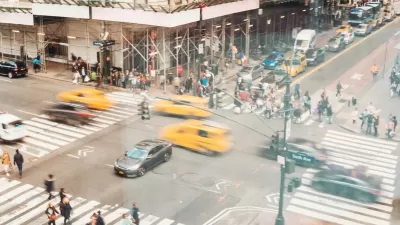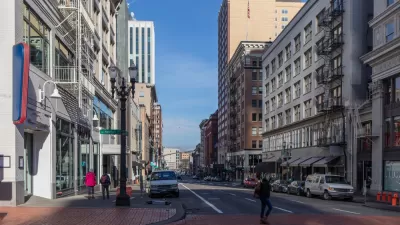After a decade of steady declines in traffic-related fatalities in New York City, amid a focused effort to improve traffic safety, Robert Kolker examines why such deaths spiked upward of 23 percent in the past year.
Thanks to the efforts of Mayor Bloomberg and transportation commissioner Janette Sadik-Khan to "redesign roadways, install bicycle lanes, and implement other new safety measures," New York's streets are now being shared equitably by cars, walkers, and cyclists "[t]o a greater degree than at any time since before World War II," says Kolker. In light of these efforts, which have made New York’s traffic-fatality rate far lower than many other big cities’, Kolker asks what is to blame for the recent spike in such deaths: is it a fluke or does it show the limits of traffic safety design and engineering?
"Sadik-Khan says the number may be a fluke. She notes that New York’s downward trend in deaths has never been consistent year-to-year. 'In fact, every other year since 2005 has seen a slight uptick in fatalities—2006, 2008, and 2010—compared to the record lows in the intervening years when the number nose-dived.'”
"Safety advocates, however, argue that the city is still overlooking critical problems. Although the new bike lanes protect riders in some ways, for instance, critics say that sharing ever-narrowing roadways has created new hazards...Cars still speed, drivers still drink, and jaywalkers still pay no attention, especially with smartphones to distract them."
“I wonder if we’ve reached a critical mass where so many people are looking down and so many people are listening to headphones and so many drivers are texting that the probability of an inattentive walker and an inattentive driver is much greater,” says Sam Schwartz, a.k.a. Gridlock Sam, the transportation consultant and traffic guru.
"Safety advocates say the DOT needs to continue to look for new engineering solutions that can help slow down speeding vehicles. But the biggest problem, they say, lies with law enforcement."
FULL STORY: Death by Car

Maui's Vacation Rental Debate Turns Ugly
Verbal attacks, misinformation campaigns and fistfights plague a high-stakes debate to convert thousands of vacation rentals into long-term housing.

Planetizen Federal Action Tracker
A weekly monitor of how Trump’s orders and actions are impacting planners and planning in America.

San Francisco Suspends Traffic Calming Amidst Record Deaths
Citing “a challenging fiscal landscape,” the city will cease the program on the heels of 42 traffic deaths, including 24 pedestrians.

Defunct Pittsburgh Power Plant to Become Residential Tower
A decommissioned steam heat plant will be redeveloped into almost 100 affordable housing units.

Trump Prompts Restructuring of Transportation Research Board in “Unprecedented Overreach”
The TRB has eliminated more than half of its committees including those focused on climate, equity, and cities.

Amtrak Rolls Out New Orleans to Alabama “Mardi Gras” Train
The new service will operate morning and evening departures between Mobile and New Orleans.
Urban Design for Planners 1: Software Tools
This six-course series explores essential urban design concepts using open source software and equips planners with the tools they need to participate fully in the urban design process.
Planning for Universal Design
Learn the tools for implementing Universal Design in planning regulations.
Heyer Gruel & Associates PA
JM Goldson LLC
Custer County Colorado
City of Camden Redevelopment Agency
City of Astoria
Transportation Research & Education Center (TREC) at Portland State University
Jefferson Parish Government
Camden Redevelopment Agency
City of Claremont





























